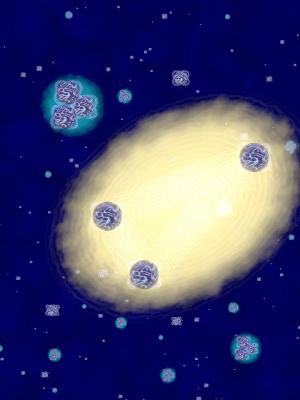May 4 2015
In 1970, Vitaly Efimov analysed a three-body quantum system in which the attraction between two bodies reduced such that they become unbound. His prediction was that instead of breaking up, the molecule consisting of three particles can support an infinite number of bound states with huge distances between the binding partners. "Every classical notion as to why such a structure remains stable fails here", explains Prof. Reinhard Dörner, head of the research group at the Institute for Nuclear Physics.
 This is efimov trimer in a gas beam of other particles. The three helium atoms form an acute triangle, their distance from the quantum cloud, shown in yellow, amounts to a hundredfold of the size of the atoms. Credit: GU
This is efimov trimer in a gas beam of other particles. The three helium atoms form an acute triangle, their distance from the quantum cloud, shown in yellow, amounts to a hundredfold of the size of the atoms. Credit: GU
This counter-intuitive prediction led to the currently booming field of "Efimov physics". It soon became apparent that a system consisting of three helium atoms, a so-called trimer, would be the prime example of this quantum mechanical effect. But all experiments conducted to prove the existence of the gigantic, extremely weakly bound helium system failed.
In 2006, physicists at the University of Innsbruck first found indirect indications of Efimov systems in cold quantum gases of caesium atoms. In the atom traps they used, the interaction between the particles can be externally controlled. Efimov systems, however, as soon as they appear, are ejected from the artificial environment of the trap and fall apart unseen.
The Frankfurt physicist Dr. Maksim Kunitski, of the research group of Prof. Dörner has now produced a stable Efimov system consisting of three helium atoms, by pressing gaseous helium at a temperature of only eight degrees above absolute zero through a tiny nozzle into a vacuum. In this ultracold molecular beam, helium molecules with two, three or more helium atoms are formed. By diffraction of the molecular beam at a super-fine transmission grating, the physicist was able to spatially separate the trimers.
The researchers created an exploded view of this Efimov state which directly show the structure of and, in particular, the distances between the atoms in the trimer. They ionized each helium atom of the molecule with the help of a laser beam. Due to the electrostatic repulsion, the now triply positively charged trimer broke apart explosively. Subsequently, using the COLTRIMS microscope developed at the Goethe University, researchers measured the momenta of the helium ions in three-dimensions, which allowed to reconstruct the geometry of the trimer.
In collaboration with the theoretician Doerte Blume of Washington State University in the USA, Maksim Kunitski found out that only one of the many possible Efimov states had in fact occurred naturally in the molecular beam. The distances between bonds in the huge molecule extend to more than 100 angstroms (compared to a mere two angstroms in a water molecule). Thereby, the helium atoms do not form an isosceles triangle, but are arranged asymmetrically. That correlates well with the theoretical predictions that have already existed for many years.
"This is the first stable Efimov system that has ever been discovered. The three-body system flies through the laboratory inside the vacuum chamber without further interaction and without the need for external fields", Dörner explains. "Maksim Kunitski has conducted this ground breaking work in a laser laboratory at the Goethe University Frankfurt. He did not need a big machine to accomplish this."
"The Efimov state is not an exotic special case, but rather an example of a universal quantum effect that plays an essential role in many areas of physics", Kunitski explains. Examples of this are cold atoms, clusters, nuclear physics and recently also solid-state physics. Moreover, there are also first reports about its significance in biology.
Reinhard Dörner could afford to tackle a research project that was so risky with respect to its prospects of success because in 2009 the German Research Foundation (DFG) made 1.25 million Euros available as part of its Koselleck programme. "It was a rather bold plan", says Dörner in retrospect, "but now, at the end of the project and really only because the DFG provided me with this large amount for a risky project without detailed planning - the search was successful."